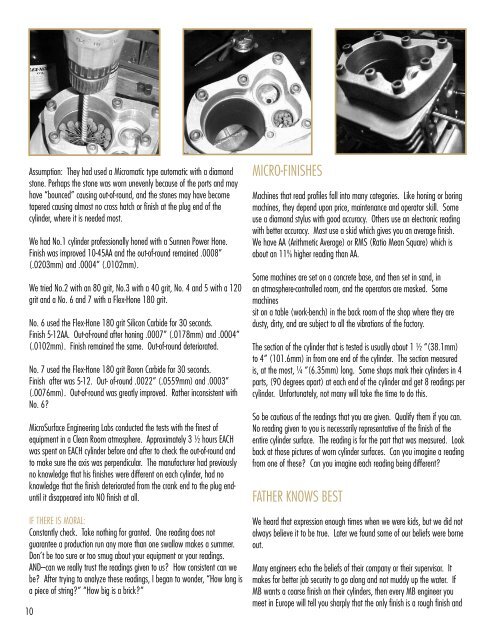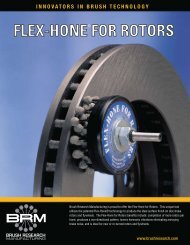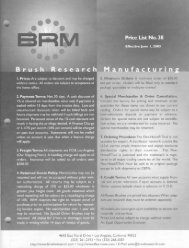Common Practices In CYLINDER BORING, HONING, AND WALL ...
Common Practices In CYLINDER BORING, HONING, AND WALL ...
Common Practices In CYLINDER BORING, HONING, AND WALL ...
Create successful ePaper yourself
Turn your PDF publications into a flip-book with our unique Google optimized e-Paper software.
Assumption: They had used a Micromatic type automatic with a diamond<br />
stone. Perhaps the stone was worn unevenly because of the ports and may<br />
have “bounced” causing out-of-round, and the stones may have become<br />
tapered causing almost no cross hatch or finish at the plug end of the<br />
cylinder, where it is needed most.<br />
We had No.1 cylinder professionally honed with a Sunnen Power Hone.<br />
Finish was improved 10-45AA and the out-of-round remained .0008”<br />
(.0203mm) and .0004” (.0102mm).<br />
We tried No.2 with an 80 grit, No.3 with a 40 grit, No. 4 and 5 with a 120<br />
grit and a No. 6 and 7 with a Flex-Hone 180 grit.<br />
No. 6 used the Flex-Hone 180 grit Silicon Carbide for 30 seconds.<br />
Finish 5-12AA. Out-of-round after honing .0007” (.0178mm) and .0004”<br />
(.0102mm). Finish remained the same. Out-of-round deteriorated.<br />
No. 7 used the Flex-Hone 180 grit Boron Carbide for 30 seconds.<br />
Finish after was 5-12. Out- of-round .0022” (.0559mm) and .0003”<br />
(.0076mm). Out-of-round was greatly improved. Rather inconsistent with<br />
No. 6<br />
MicroSurface Engineering Labs conducted the tests with the finest of<br />
equipment in a Clean Room atmosphere. Approximately 3 ½ hours EACH<br />
was spent on EACH cylinder before and after to check the out-of-round and<br />
to make sure the axis was perpendicular. The manufacturer had previously<br />
no knowledge that his finishes were different on each cylinder, had no<br />
knowledge that the finish deteriorated from the crank end to the plug enduntil<br />
it disappeared into NO finish at all.<br />
IF THERE IS MORAL:<br />
Constantly check. Take nothing for granted. One reading does not<br />
guarantee a production run any more than one swallow makes a summer.<br />
Don’t be too sure or too smug about your equipment or your readings.<br />
<strong>AND</strong>---can we really trust the readings given to us How consistent can we<br />
be After trying to analyze these readings, I began to wonder, “How long is<br />
a piece of string” “How big is a brick”<br />
10<br />
MICRO-FINISHES<br />
Machines that read profiles fall into many categories. Like honing or boring<br />
machines, they depend upon price, maintenance and operator skill. Some<br />
use a diamond stylus with good accuracy. Others use an electronic reading<br />
with better accuracy. Most use a skid which gives you an average finish.<br />
We have AA (Arithmetic Average) or RMS (Ratio Mean Square) which is<br />
about an 11% higher reading than AA.<br />
Some machines are set on a concrete base, and then set in sand, in<br />
an atmosphere-controlled room, and the operators are masked. Some<br />
machines<br />
sit on a table (work-bench) in the back room of the shop where they are<br />
dusty, dirty, and are subject to all the vibrations of the factory.<br />
The section of the cylinder that is tested is usually about 1 ½ “(38.1mm)<br />
to 4” (101.6mm) in from one end of the cylinder. The section measured<br />
is, at the most, ¼ “(6.35mm) long. Some shops mark their cylinders in 4<br />
parts, (90 degrees apart) at each end of the cylinder and get 8 readings per<br />
cylinder. Unfortunately, not many will take the time to do this.<br />
So be cautious of the readings that you are given. Qualify them if you can.<br />
No reading given to you is necessarily representative of the finish of the<br />
entire cylinder surface. The reading is for the part that was measured. Look<br />
back at those pictures of worn cylinder surfaces. Can you imagine a reading<br />
from one of these Can you imagine each reading being different<br />
FATHER KNOWS BEST<br />
We heard that expression enough times when we were kids, but we did not<br />
always believe it to be true. Later we found some of our beliefs were borne<br />
out.<br />
Many engineers echo the beliefs of their company or their supervisor. It<br />
makes for better job security to go along and not muddy up the water. If<br />
MB wants a coarse finish on their cylinders, then every MB engineer you<br />
meet in Europe will tell you sharply that the only finish is a rough finish and





